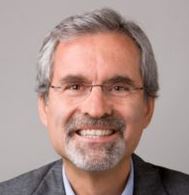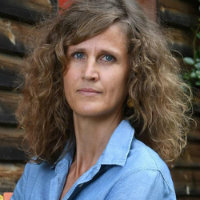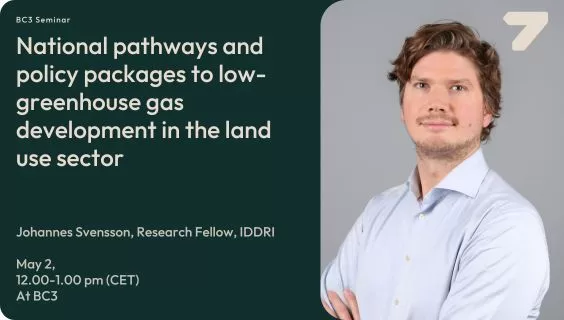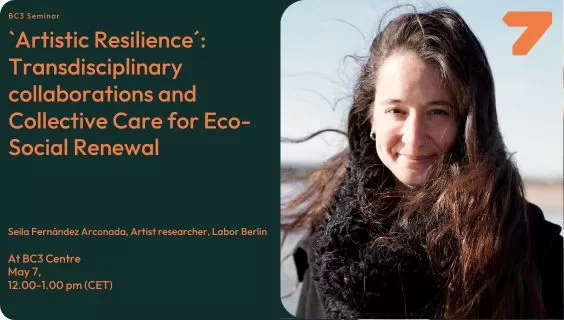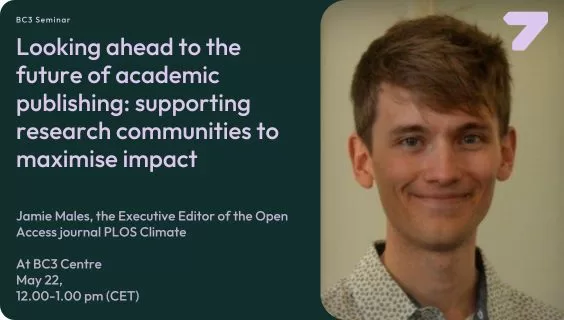BC3 Seminars: The Norwegian electric car policy; environmental friendly or an economic disaster?
BC3-Basque Centre for Climate Change Sede Building 1, 1st floor, Scientific Park of the University of the Basque Country, Leioa, Bizkaia, SpainProf. Anders Skonhoft
Norwegian University of Science and Technology
As a result of generous policies to increase the use of electric vehicles (EVs), the sales of EVs in Norway is rapidly increasing. Due to the subsidies, driving an EV implies very low cost to the owner on the margin, probably leading to more driving at the expense of public transport and cycling. Moreover, because most EVs´driving range is low, the policy gives Norwegian households incentives to purchase a second car, again stimulating the use of private cars instead of public transport and cycling. These effects are analysed in light of possible benefits of utilizing EVs versus conventional cars.
Presented his Research Line
BC3-Basque Centre for Climate Change Sede Building 1, 1st floor, Scientific Park of the University of the Basque Country, Leioa, Bizkaia, SpainProf. Joan Sabaté
LOMA LINDA
University School of Public Health (California, USA)
BC3 has in place a program called BC3 Visiting Programme under the attainment of its strategic objectives, Talent Attraction.
The aim of this programme is to promote research and dialogue between BC3 and other worldwide leading institutions, by supporting and hosting local and international professors wishing to undertake research at BC3.
BC3 Seminars: Demand and supply assessment of ecosystem services in the case of Japan
BC3-Basque Centre for Climate Change Sede Building 1, 1st floor, Scientific Park of the University of the Basque Country, Leioa, Bizkaia, SpainProf. Kiichiro Hayashi
Institute of Materials and Systems for Sustainability Division of Systems Research, Nagoya University, Japan.
Makoto Oba
Principal researcher of National Institute for Environmental Studies, Japan.
This study focuses on the assessment of the provisioning potential of ecosystem services(ESs) and the demand assessment of ESs by GIS. The case study was conducted in Aichi prefecture, Japan, focusing on forest ESs. First, spatial distributions of forest ecosystem services were estimated by using process models at regional-scale. The process-based ecosystem model predicts quantitatively material cycles and growth of biomass with change of forest management. Second the demand and beneficiary spatial distributions were estimated by several questionnaire surveys. The study site included not only source forest towns but also surrounding municipalities for beneficiary distribution mapping. Third these results were overlying by utilizing GIS. After overlaying each ES map, the ES demand and supply relation were studied. Based on the results, a low-carbon policy can be suggested for promoting energy-use of woody biomass and carbon stock of buildings in socio-system.
5th Workshop on Input-Output Analysis
Workshop: 5th Workshop on Input-Output Analysis 29th and 30th September 2016 Faculty of Sarriko (UPV/EHU) , Bilbao, Spain. About the Workshop: On September 29 and 30, […]
Regional workshop: “Understanding multiscale linkages in Ecosystem services assessment using ARIES Platform”
Quantifying and mapping ecosystem services (ES) that reach beneficiaries provide a key to distinguishing between the potential for benefit provision and the benefits actually accrued by […]
Conferencia del investigador de BC3, Dr. Mikel Gonzalez-Eguino en el XVII Seminario Internacional UNICEF
Ilustre Colegio de Abogados del Señorio de Vizcaya Rampas de Uribitarte, 3, Bilbao, BizkaiaDicha conferencia será impartida en el marco del XVII Seminario Internacional UNICEF.
Aplicación de la Convención sobre los derechos del niño .
El impacto de los Conflictos, Cambio climático y Desigualdad en la infancia.
BC3 Seminars: Exploring option pricing via volatility asymmetry
BC3-Basque Centre for Climate Change Sede Building 1, 1st floor, Scientific Park of the University of the Basque Country, Leioa, Bizkaia, SpainIsabel Casas
Marie Skłodowska-Curie Fellow at BCAM - Basque Center for Applied Mathematics
This paper proposes to model the asymmetric response of the volatility to the sign of past returns (leverage effect) nonparametrically in the context of stochastic volatility models. The new stochastic volatility specifications are able to generate volatility clustering and allow for a flexible time-varying functional form of the volatility asymmetry. The objective is to improve option price forecasting by improving the volatility forecasting given that the option pricing depends mainly on the moneyness, maturity and the asset price volatility. The forecasting performances of the new models are compared with three parametric asymmetric stochastic volatility models via intensive Monte Carlo experiments and empirically by fitting the benchmarks and our proposals to two series of financial returns. Using S&P 400 MidCap and S&P 500 options for the 2008 and 2013-1014 periods, we examine parametric and nonparametric forecast performance from three perspectives: (1) underlying volatility forecast accuracy, (2) out-of-sample pricing forecast, and (3) dynamic delta hedging effective cost.
To achieve these objectives, our group will explore the synergies and trade-offs between multiple dimensions of space and time, and between water, energy, and agricultural sectors.. This multi-scale approach will be adopted to propose preferable solutions to approach global challenges for achieving sustainability, while trying to integrate a nexus approach from river basin up to country and global scales. Additionally, we will characterize how uncertainty is perceived by stakeholders and policy makers, how trust in models influences implementation and how researchers can best communicate and disseminate their methodologies, results, and broader impacts to policy relevant stakeholders.
BC3 Seminars: Catchment zoning to enhance co-benefits and minimise trade-offs between ecosystem services and biodiversity conservation
BC3-Basque Centre for Climate Change Sede Building 1, 1st floor, Scientific Park of the University of the Basque Country, Leioa, Bizkaia, SpainDr. Virgilio Hermoso and Dr. Simone Langhans.
Integrating ecosystem services (ES) in landscape planning can help identify conservation opportunities by fostering co-benefits between biodiversity conservation and maintenance of regulation and cultural ecosystem services. However, potential trade-offs that arise from accounting for provisioning ES incompatible with biodiversity conservation should be considered. These trade-offs have been, however, overlooked to date, especially in freshwater systems. I will demonstrate how to identify priority areas to enhance co-benefits between conservation of freshwater biodiversity (139 species of freshwater fish, turtles and waterbirds) and two regulation-cultural ES (carbon storage/ flood retention and perennial water availability) while minimising trade-off with two provisioning ES (groundwater provisioning and recreational fisheries) using a catchment in northern Australia as a case study. This novel approach can help address the increasingly complex catchment management challenges arising from increasing demand for provisioning services and diminishing availability of resources, and management and planning challenges in other realms facing similar problems.
BC3 Seminars: “How decision analysis theory can be used for river management”
BC3-Basque Centre for Climate Change Sede Building 1, 1st floor, Scientific Park of the University of the Basque Country, Leioa, Bizkaia, SpainDr. Simone Langhans
Leibniz-Institute of Freshwater Ecology and Inland Fisheries, Berlin, Germany
River assessment and management are challenges to scientists and practitioners alike. Rivers, being highly complex ecosystems, are difficult to characterize with adequate indicators and predicting outcomes of river management actions are, therefore, sophisticated and affected by large uncertainty. Moreover, many stakeholders with potentially diverging interests are involved or affected by river management decisions. Although different approaches to river assessment and management exist, there is a need for a concept that accounts for these difficulties. Decision analysis theory provides appropriate techniques for developing an integral river management concept. In this talk, I will explain the different elements of such a river management concept, i.e. objectives, results of river state assessment, potential management actions, and predictions of system response to management actions, and illustrate the details with different examples from Switzerland and New Zealand.
BC3 Seminars: Species distribution modelling of freshwater organisms
BC3-Basque Centre for Climate Change Sede Building 1, 1st floor, Scientific Park of the University of the Basque Country, Leioa, Bizkaia, SpainDr. Sami Domisch
Leibniz-Institute of Freshwater Ecology and Inland Fisheries, Berlin, Germany
Species occurrence information consists in general of heterogeneous data, ranging from point records that provide accurate information in geographic and environmental space, to coarse expert range maps accounting for dispersal barriers or historical biogeographic limits. Combining both data types in a species distribution model (SDM) framework using newly-developed (1 km) freshwater-specific environmental variables allows to make fine-grain and improved estimates of species distributions. I will demonstrate how the freshwater-specific variables can be easily created for any given region, and present the modelling framework using the North American freshwater fish fauna as a case study. The predictions highlight diversity patterns and hotspots along the stream network, further contributing to the understanding of the current-day environmental factors that shape the distribution of freshwater fish ranges, with the potential in ultimately aiding conservation and management efforts.

